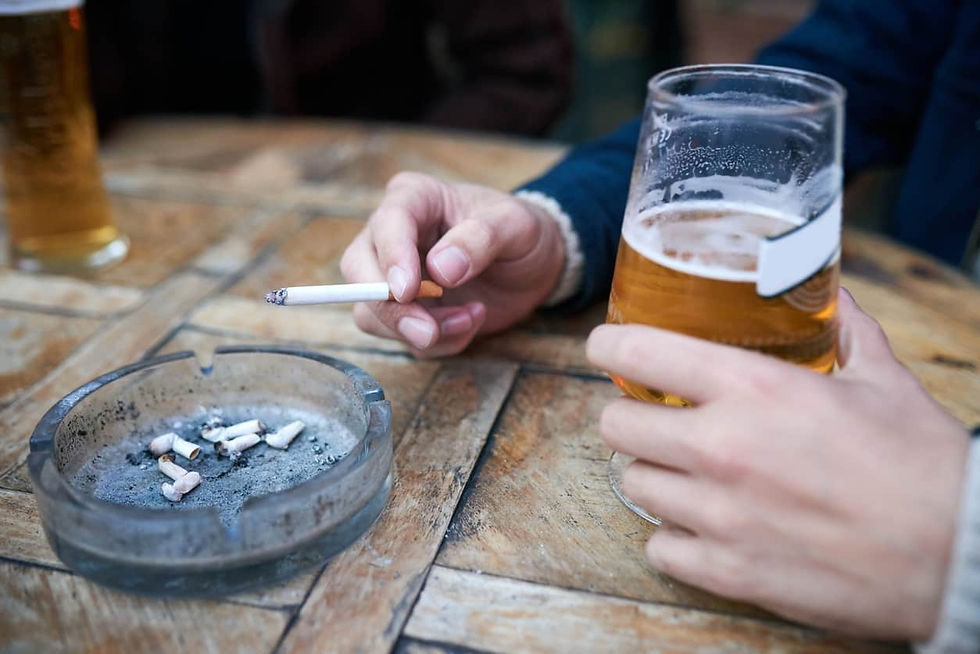Withdrawal Neurons: Why The Brain Pushes Us Back To Alcohol
- Lidi Garcia
- Sep 30
- 4 min read

This study showed that the brain forms specific groups of neurons that register the association between drinking alcohol and the relief of negative withdrawal symptoms. These circuits appear to underlie the compulsive pursuit of alcohol and help explain why relapses occur so frequently in addicted individuals.
The human brain and that of other animals have a fundamental ability: learning to associate certain environmental stimuli (sounds, smells, places, objects) with good or bad experiences. This type of learning is called conditioning.
It works like this: if a stimulus is followed by something pleasant, it becomes rewarding; if it is followed by something unpleasant, it becomes aversive. This process is vital for survival, as it helps us both seek out good things (such as food and shelter) and avoid dangerous situations.
In the case of drug addiction, these associations can become very strong. For example, an alcoholic may learn to associate certain places or situations with immediate relief from the negative symptoms of withdrawal (anxiety, malaise, sadness). In this case, the brain learns that drinking is not only pleasurable, but also a way to escape suffering.

This mechanism is called negative reinforcement because the behavior (drinking) serves to eliminate something unpleasant (withdrawal symptoms). This learning ends up being very powerful and can lead to compulsive behavior, in which the person continues drinking even when they know it will have negative consequences.
Scientists wanted to better understand which groups of neurons in the brain are involved in this type of learning. When the brain receives motivational stimuli (such as signals linked to drinking or withdrawal), only a few specific neurons are activated. These small groups are called neuronal ensembles.
The idea of the study was to investigate how these ensembles participate in the compulsive pursuit of alcohol, especially when consumption is linked to the relief of negative withdrawal symptoms. To do this, researchers at The Scripps Research Institute, USA, used rats as an experimental model.

They divided the animals into different groups to compare situations:
- Dependent group with withdrawal-linked learning (DEP-WDL): rats that developed alcohol dependence and learned to associate environmental cues with withdrawal relief when drinking.
- Non-dependent group with withdrawal-linked learning (NDEP-WDL): rats that were not dependent but also underwent learning situations.
- Dependent group without withdrawal-linked learning (DEP-NWDL): rats that were dependent but showed no association between stimuli and withdrawal.
- Non-dependent group without learning (NDEP-NWDL): control group, without dependence and without associations with withdrawal.
This way, the scientists were able to isolate the effects of being dependent or not, and having or not gone through the learning process that alcohol alleviates adverse symptoms.

They then analyzed which neurons were activated in specific brain regions when the rats were exposed to alcohol-associated stimuli. This was done by measuring neuronal activity in areas such as the paraventricular nucleus of the thalamus, the central amygdala, and the dorsal striatum, regions known to be linked to emotions, motivation, and compulsive behavior.
The scientists found that specific populations of neurons in these regions were activated when the behavior was associated with negative reinforcement (withdrawal relief). This suggests that distinct brain circuits encode this learning and may be directly linked to relapse vulnerability in alcohol addicts.

Neuroanatomical summary illustration of the recruitment of active neurons associated with context-induced alcohol seeking in rats with WDL experience and dependent drinking (B) versus context-induced alcohol seeking in non-dependent rats with a history of social drinking (A). BLA, basolateral amygdala; CeA, central amygdala; DEP, dependent; DS, dorsal striatum; IL, infralimbic cortex; LH, lateral hypothalamus; NAc, nucleus accumbens; NDEP, non-dependent; PL, prelimbic cortex; PVT, paraventricular nucleus of the thalamus; WDL, withdrawal-related learning.
These findings show that alcohol cravings arise not only because it provides pleasure, but also because the brain learns that it alleviates distress.
This type of learning is imprinted in specific neuronal groups, which may explain why it is so difficult to stop drinking and why relapses are common. Understanding these mechanisms paves the way for developing more effective treatments for addiction, focusing precisely on these brain circuits.
READ MORE:
Recruitment of Neuronal Populations in the Paraventricular Thalamus of Alcohol-Seeking Rats With Withdrawal-Related Learning Experience
Hermina Nedelescu, Elias Meamari, Nami Rajaei, Alexus Grey, Ryan Bullard, Nathan O’Connor, Nobuyoshi Suto, and Friedbert Weiss
Biological Psychiatry Global Open Science.Volume 5, Issue 6, November 2025, 100578.DOI: 10.1016/j.bpsgos.2025.100578
Abstract:
Stimulus-reactive neuronal populations are groups of neurons that become activated by environmental stimuli. These sparsely activated neuronal assemblies are implicated in encoding associations between environmental contexts and subjectively rewarding or aversive experiences that regulate behavior. How positive or negative hedonic states are represented in brain neurocircuits is a fundamental question relevant for understanding the processing of emotionally meaningful stimuli that drive appropriate versus maladaptive behavior. It is well known that animals avoid noxious stimuli and experiences. However, little is known about how the conditioning of environmental stimuli to behavior that leads to amelioration of dysphoric states establishes powerful associations that lead to compulsive maladaptive behavior. Here, we sought to identify stimulus-reactive neurons that may mediate the conditioned effects of environmental stimuli associated with the reversal of dysphoric alcohol withdrawal states using a dependent withdrawal-related learning (WDL) experimental condition (DEP-WDL) (N = 13) and 3 controls: nondependent WDL (NDEP-WDL) (N = 12), dependent no-WDL (DEP-NWDL) (N = 9), NDEP-NWDL (N = 9). The results document a role for clusters of neurons in the paraventricular nucleus of the thalamus (N = 8), the central nucleus of the amygdala (N = 8), and the dorsal striatum (N = 9) in this conditioned negative reinforcement process. These findings suggest that associations between reversal of negative hedonic states and environmental contexts are encoded in distinct neuronal populations that may serve as a neural substrate of compulsive alcohol seeking and vulnerability to relapse associated with reward dysregulation and hedonic allostasis.



Comments